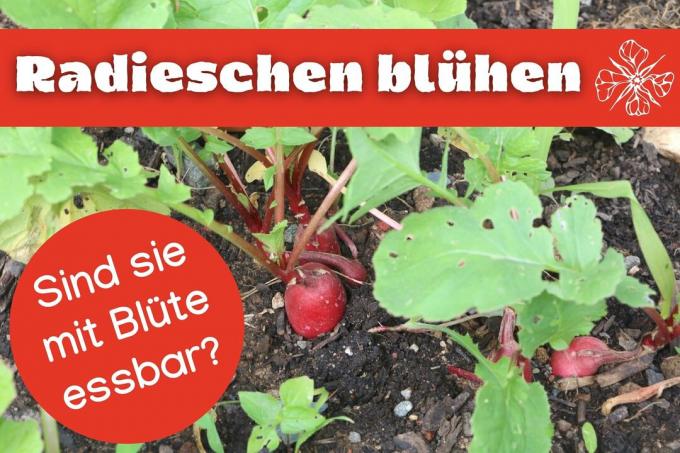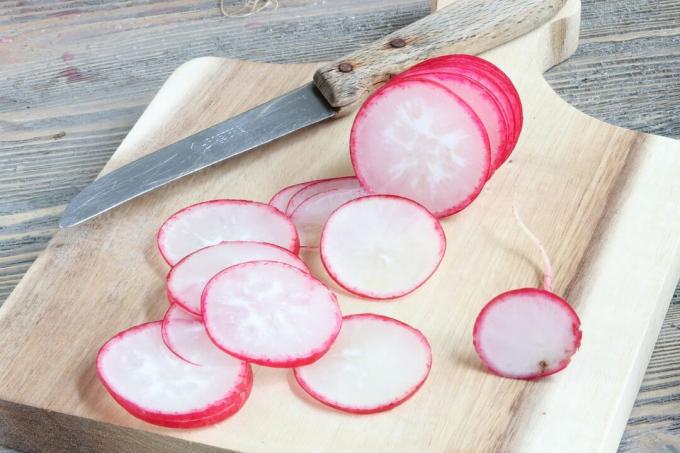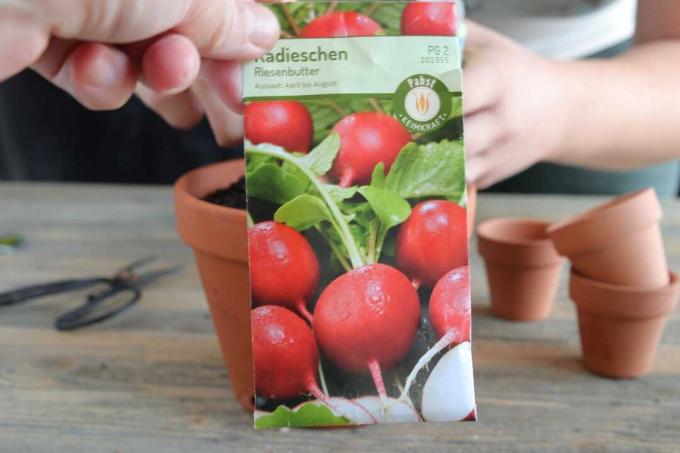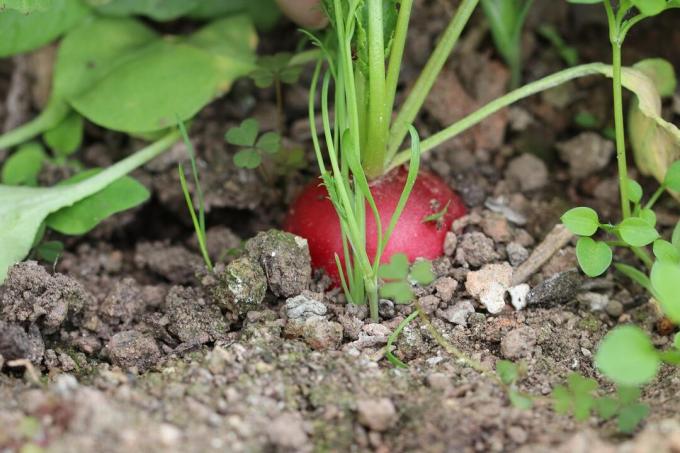
contents
- Toxic or edible?
- This is how the tuber changes
- Factors influencing flowering time
- prevent crop losses
- frequently asked Questions
Radishes (Raphanus sativus var. sativus) score points for being undemanding and quick to harvest. Therefore, they are particularly in demand for home cultivation. Unfortunately, radishes sometimes bloom unexpectedly early. Are they still edible then?
In a nutshell
- Tubers edible during flowering but increasingly bitter and woody
- Tuber maturity, deep sowing and warm, dry weather promote early flowering
- Check harvest level closely, harvest promptly
- after flowering, only harvest edible seed pods or ripe seeds
- Summer varieties tolerate more heat and drought and are more bolt resistant
Toxic or edible?
Despite claims to the contrary flowering radishes are not poisonous! The red tubers remain edible without hesitation. But this all-clear does not mean that the harvest time can go on happily. Because the formation of flowers is accompanied by changes in the tuber. The further the flowering progresses, the more inedible it becomes.
This is how the tuber changes
The ideal radish bulb is crunchy and tender, has a refreshing aroma with a slight spiciness. Once the plant turns its attention to the buds, its taste and texture will begin to change.

- Bitter substances are stored
- This makes the taste more and more bitter
- fibrous areas are increasingly forming
- Tuber tastes woody
- the interior becomes drier
importance for the harvest season
Since blooming radishes are not a pleasure, the blooming season puts a clear end to the harvest season. Consequently, all tubers should have been pulled out of the ground before the first flowers appear. To do this, however, the gardener needs to know when the radishes he has sown will bloom.
Factors influencing flowering time
in the Spring sown radishes usually bloom in May or June. However, some factors can cause them to shoot up and flower prematurely.
Incorrect sowing depth and spacing

If radish seeds are sown too deeply, they will either not germinate at all, or the plants will shoot up and flower without first forming proper tubers. Planting too tightly leads to competition for nutrients, which in turn leads to premature flowering. What you need to know about sowing depth and planting distance:
- Cover seeds with just a little soil
- ideal sowing depth is 0.5 cm
- never sow deeper than 1 cm
- Maintain a planting distance of 3-5 cm
Sunny location
In a full sun location there is a risk that it will provide too much warmth and too dry soil. Both factors ensure that the popular bulbous plants flower earlier.
Tip: If you do not have a semi-shady bed in the garden, at least sow radishes next to taller, shady vegetables.
Warm weather
When days are persistently hot and dry, flowering often occurs before the bulbs are fully formed. The risk of early flowering is therefore greatest in summer.

Tip: If you don't want to do without your own radishes in summer, you should definitely grab them Summer varieties such as "Carnita", "Olivia", "Rota", "Sora" or "Vitessa", which are considered bolt-resistant are valid.
ripe tubers
If ripe tubers remain in the bed, this in no way prolongs the harvest. Instead, substances are formed without delay that trigger the formation of flowers. This is progressing in rapid steps, so that the first flowers will soon appear.
prevent crop losses
Every gardener should keep a close eye on the development of the radish so that no tuber is lost.
- Note the sowing date
- Aim for harvest about 4-6 weeks later
- pay attention to the influence of warm weather
- Check the ripeness of the tubers regularly
- harvest quickly when bulbs are 2-3 cm in diameter
- Harvest window in spring is about 10 days
- in summer only 3-4 days
- if necessary, also harvest smaller tubers
- refrigerate until needed (a few days)

If shooting has already started unexpectedly, everything should be harvested immediately. The slightly bitter taste of the tubers may still be acceptable. Individual woody areas can be cut off.
Tip: In order not to miss the beginning of the harvest, you should check the degree of ripeness of the tubers daily at the latest three weeks after sowing.
Use other plant parts
If the plants are already blooming unexpectedly, on the one hand you can be sad about the loss of the bulbs. On the other hand, another culinary voyage of discovery awaits. The yellowish-brown pods that form after withering are edible and an interesting salad ingredient. Its aroma is mildly spicy with a hint of mustard and its consistency is soft.
frequently asked Questions
Yes, that is possible. But it is not recommended. Plants from seeds of shooting plants also tend to shoot. It is better to grow healthy sprouts from harvested seeds in winter.
Of course, you have the option of choosing a more shady location for the radish plants. Otherwise, you can set up bamboo mats on warm days to provide shade.
Partly. This prevents many tubers from being ready for harvest at the same time and having to be harvested within a few days. Weather's ability to act as a bloom accelerator is unaffected.



